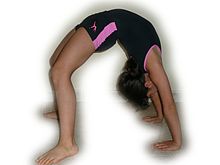Bridge (gymnastics)
The bridge is a gymnastic exercise . The body is bent back so that the hands touch the ground. The bridge can be built up from a standing position by bending back. On the other hand, it can be reached from the supine position.
As a modified form, there is also the shoulder bridge . The gymnast develops it from the supine position by placing his feet hip-width apart so that the lower leg is perpendicular to the floor. The arms are next to the upper body. The gymnast now lifts his buttocks until there is a straight line from shoulder to knee. The arms can now be put back over the top. Depending on the version, the upper back, lower back or legs are trained more often.
Variations:
- walk with your feet on your toes
- bend one leg at a right angle and place your foot on the other knee
- stretch one leg parallel to the floor
- hold one leg upright.
Effect of the bridge or shoulder bridge:
- Strengthening the muscles in the pelvic floor
- Stretching the front of the body
- Mobility of the spine in its entire length
- Strengthening of the back muscles or leg muscles depending on the version
Since both the bridge and the shoulder bridge are reverse exercises, people who are prone to dizziness and / or headaches and migraines should be careful with these exercises. Problems in the spine also need to be considered.
